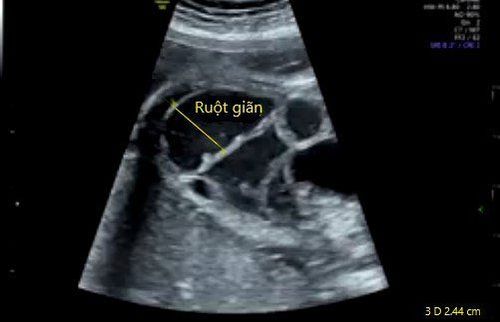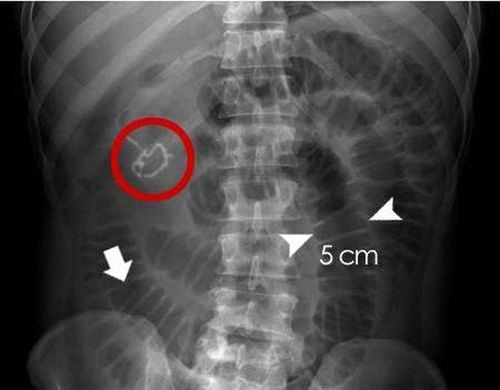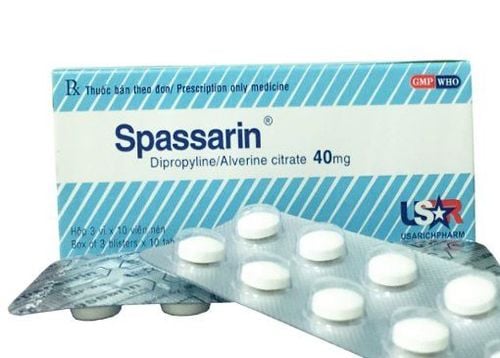This is an automatically translated article.
The article was professionally consulted by MSc Vu Van Quan - Department of General Surgery & Anesthesia, Vinmec Hai Phong International General Hospital. The doctor has more than 10 years of experience working in the field of General Gastroenterology.Meconium intestinal obstruction is one of the most common surgical emergencies in young children, which mainly occurs in infancy in the first 15 days after birth. Prolonged obstruction of meconium can lead to complications such as intestinal perforation, intestinal volvulus, infection... Depending on the situation as well as the degree of obstruction, intestinal obstruction due to meconium can be treated by the method of conservative or surgical.
1. Treatment of meconium bowel obstruction
A few hours after birth, newborns often pass meconium. Meconium is characterized by its dark green color, viscous, digestive juices and epidermal components of the baby's skin. In some cases, children do not pass meconium, meconium adheres to the entire mucosa of the terminal ileum, causing intestinal obstruction due to meconium. This adhesion occurs due to the presence of mycoprotein mucus in the intestinal tract. This mucus is present in the liver, pancreas, bronchi, and sweat glands. Therefore, bowel obstruction due to meconium is also considered as an early warning sign of the risk of pancreatic cystic fibrosis.Meconium intestinal obstruction syndrome is characterized by the following symptoms: vomiting green fluid, children do not pass meconium, abdominal distention accompanied by signs of floating bowel.
Intestinal obstruction due to meconium, if detected early, can be treated without affecting the health of the child. Depending on the condition of the bowel obstruction as well as the health status of the child and whether there are signs of complications or not, the doctor will have different treatment methods. Talking about the treatment of intestinal obstruction due to meconium, it is currently divided into two main treatment methods:
Conservative treatment: Using enemas to increase laxatives, help children pass stools, reduce intestinal obstruction caused by meconium , and at the same time place an intravenous line to rehydrate the child . Apply to patients who come early, when the bowel obstruction due to meconium has been correctly diagnosed and there are no signs of complications. Surgical treatment: The aim is to cut out the segment of intestine blocked by meconium, restore and circulate the intestine. Indicated for treatment when the patient presents with symptoms of complications such as intestinal perforation, volvulus, or when the patient has not responded to conservative therapy or the patient has not been correctly diagnosed with fecal bowel obstruction. caused by su.

2. Surgical methods for the treatment of meconium bowel obstruction
The surgical methods to treat meconium obstruction include:Bishop - koop surgery:
It is a suture technique between the dilated head of the intestine above the obstructed segment and the atrophied small intestine below the obstructed segment of stool. rubber, with drainage of the lower intestine. Advantages: Safe, relatively wide connection mouth should ensure bowel circulation and convenient for douching, activating the intestine below. Cons: There may be a segment of intestine that is attached to the abdominal wall, leaving the risk of intestinal fistula later, requiring surgery again. Santulli surgery:
In contrast to the Bishop-koop method, this is an end-to-end anastomosis technique between the atrophied bowel tip below with the dilated bowel tip, accompanied by an external drain. Advantages: Applicable even to cases when the lower intestine is atrophied or too short not long enough to bring out the abdominal wall to create drainage. Disadvantages: The anastomosis after surgery is often narrow, easy to leak and lose a lot of fluid. Therefore, in clinical practice, this method is rarely used. Mikulicz surgery:
Is a technique to bring out the two ends of the intestine. Advantages: The surgery is fast, simple and easy to perform. Cons: The patient has a prolonged intestinal leak, dehydration leads to rapid exhaustion. Intestinal anastomosis:
End-to-cross: It is a technique to cut the small intestine's head to make the diameter equal to the large intestine and then join it together.
Advantages: After anastomosis, there will be no excess.
Cons: Narrow mouth, poor circulation.
End-to-end, also known as pencil-style intestinal anastomosis: is the most commonly used surgical method today. This is a technique of beveling the large intestine to make it equal to the diameter of the small intestine and then suturing it.
Advantages: Overcoming all the disadvantages of other methods.
Cons: There are many sutures used, so it can increase the risk of fluid leakage at suture sites.
In addition to the above methods, there are also colectomy surgery, surgery to drain intestinal perforation, surgery to cut ligaments and remove intestinal adhesions ... However, there are now many modern alternative methods. are safer and more effective, so these methods are rarely used in clinical practice.
3. Attention to care for patients after surgery to treat meconium bowel obstruction.
After surgery, in order to ensure health and minimize postoperative complications, it is necessary to closely monitor the patient for the manifestations of the body. Note:Fully monitor the patient's vital signs, ensuring a stable body temperature. Save the gastric tube until the discharge is clear. Using intravenous antibiotics for 7 days, then depending on the child's condition to have the next drug indicated. Rehydration, electrolytes. Pay special attention to signs at the incision site and systemic signs such as fever, inflammation, infected ulcers at the incision site... In case there is an anastomosis leak, it is necessary to consider the indications for re-operation and drainage. the two ends of the intestines come out.

When a child shows signs of meconium bowel obstruction, parents can take the child to Vinmec International General Hospital for examination, diagnosis and treatment. Here, there is a team of well-trained pediatricians with high technical qualifications, rich experience in the treatment of diseases of infants, children and children under 16 years old. Vinmec is equipped with a system of modern and advanced medical supplies and professional service quality that will support high efficiency in diagnosis and treatment of patients.
Please dial HOTLINE for more information or register for an appointment HERE. Download MyVinmec app to make appointments faster and to manage your bookings easily.














